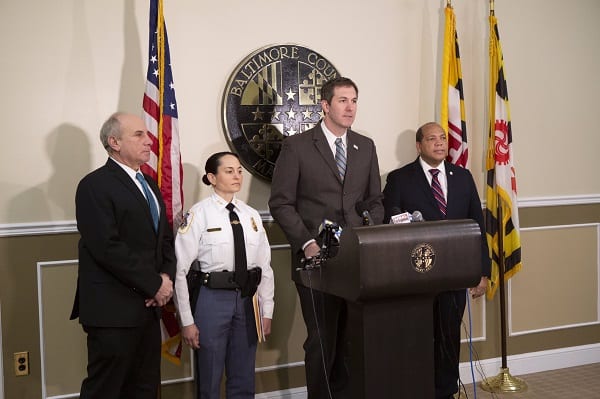TOWSON, MD—Baltimore County Executive Johnny Olszewski and Baltimore County Police Chief Melissa Hyatt on Wednesday released a multi-pronged plan focused on combating violent crime through a series of immediate and upstream interventions.
“Keeping our communities safe is among the most important responsibilities of government. Any increase in violent crime is unacceptable. We refuse to normalize violence in our communities,” Olszewski said. “This plan brings together the Baltimore County Police Department, our law enforcement partners, and all of Baltimore County government to provide both immediate and upstream interventions to enhance the safety of our communities.”
“There is no single factor that causes violent crime, and no single solution. This plan includes innovative and proven strategies that will better equip our officers to prevent and respond to crime in our communities,” Chief Hyatt said.
The increase in Baltimore County homicides in 2019 requires a decisive response, officials notes. The public safety plan was the result of a re-evaluation of crime-fighting tactics and resources.
The plan released this week focuses on five key priority areas to reduce violent crime:
1) Improved Data and Analytics: This year, the Baltimore County Police Department (BCoPD) will establish a Real Time Crime Center (RTCC), a physical center where real-time data, human intelligence, and technology are combined to drive effective deployment of resources. The RTCC will be led by experienced civilian crime analysts working alongside police officers. The RTCC will be primarily focused on the precincts that experience the greatest amount of gun violence.
2) Focused Crime Prevention: Baltimore County will increase the Baltimore County Police Department’s discretionary crime-fighting resources, enabling law enforcement to increase targeted crime prevention initiatives in “hot-spots” and at key times of activity. Coordination between the RTCC and the existing Comstat process will improve law enforcement’s ability to identify the small number of violent offenders in our communities and deploy strategies to prevent violence and victimization.
3) Attract and Retain Talent: Baltimore County will continue to invest in strategies to attract and retain high quality police officers. BCoPD recently reduced the number of sworn vacancies significantly, but attrition and retirements continue. Baltimore County will implement a pilot program for “take-home vehicles” this year, invest more in additional local recruitment efforts, implement foreign language proficiency stipends and referral bonuses, and conduct a comprehensive review of our hiring process.
4) Innovative Strategies: Baltimore County will continue to embrace proven violence reduction strategies to improve supervision and accountability. Last year, BCoPD expanded the number of area sectors from two to three, each led by a Major, allowing area commanders to more effectively focus resources. The Department also established a permanently-assigned Night Commander to provide further supervision and leadership overnight.
This year, Baltimore County will identify and implement proven violence reduction strategies, including seeking public and private resources to establish an Office of Public Safety to coordinate innovative violence reduction strategies and to convene stakeholders.
5) Strong Partnerships: Public safety has regional implications and requires regional solutions. Last year, Baltimore County played a leading role in the Organized Crime Drug Enforcement Task Force (OCDETF) with other local, state, and federal partners and continues to coordinate with the State’s Attorney’s Office on building and prosecuting high quality cases, particularly for violent gun crimes.
This year, Baltimore County will be increasing coordination and information sharing with the Baltimore Police Department about regional crime concerns and areas around the city/county border. Baltimore County is also working with the state to expand successful strategies such as the Warrant Apprehension Task Force (WATF) and the Regional Auto Theft Task Force (RATT). The county has also increased strategic collaboration with the State Division of Parole and Probation, including through joint supervision efforts and having P&P agents participate in Comstat.
In addition to these interventions, Baltimore County will continue to support additional upstream interventions in order to prevent violence from occurring in the first place, including ongoing commitment to investment in education, recreational opportunities, and strategies to grow youth summer employment, and proactive community engagement.


